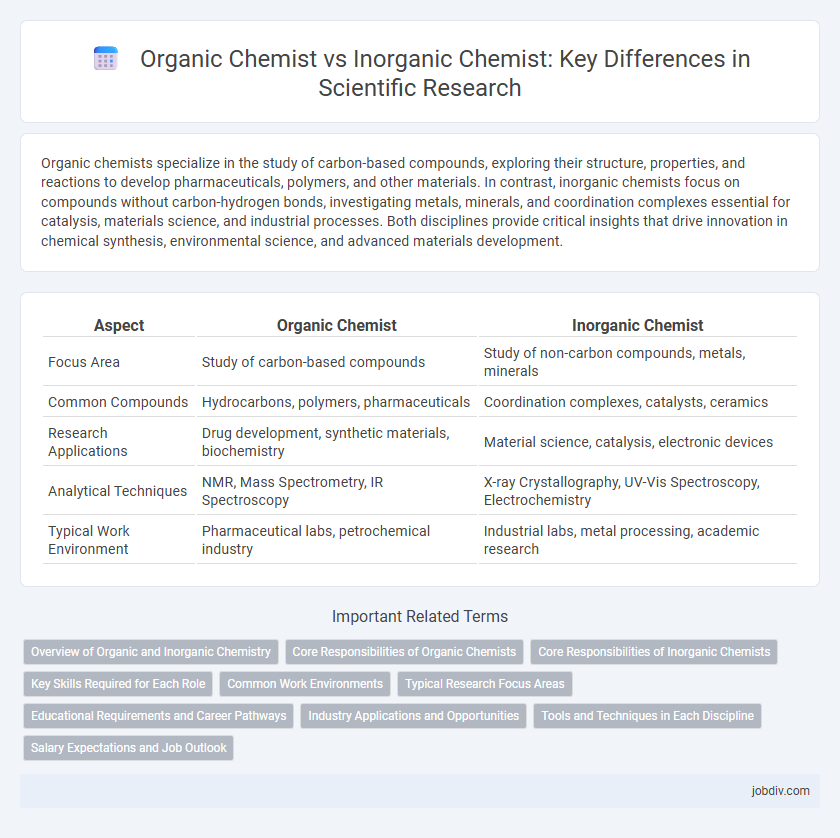Organic chemists specialize in the study of carbon-based compounds, exploring their structure, properties, and reactions to develop pharmaceuticals, polymers, and other materials. In contrast, inorganic chemists focus on compounds without carbon-hydrogen bonds, investigating metals, minerals, and coordination complexes essential for catalysis, materials science, and industrial processes. Both disciplines provide critical insights that drive innovation in chemical synthesis, environmental science, and advanced materials development.
Table of Comparison
| Aspect | Organic Chemist | Inorganic Chemist |
|---|---|---|
| Focus Area | Study of carbon-based compounds | Study of non-carbon compounds, metals, minerals |
| Common Compounds | Hydrocarbons, polymers, pharmaceuticals | Coordination complexes, catalysts, ceramics |
| Research Applications | Drug development, synthetic materials, biochemistry | Material science, catalysis, electronic devices |
| Analytical Techniques | NMR, Mass Spectrometry, IR Spectroscopy | X-ray Crystallography, UV-Vis Spectroscopy, Electrochemistry |
| Typical Work Environment | Pharmaceutical labs, petrochemical industry | Industrial labs, metal processing, academic research |
Overview of Organic and Inorganic Chemistry
Organic chemistry centers on the study of carbon-containing compounds, emphasizing their structure, properties, synthesis, and reactions, with key applications in pharmaceuticals, polymers, and biochemistry. Inorganic chemistry explores the behavior and characteristics of inorganic compounds, including metals, minerals, and coordination complexes, playing a vital role in catalysis, materials science, and environmental chemistry. Both fields contribute to advancements in chemical knowledge but differ fundamentally in their focus on carbon-based versus non-carbon-based substances.
Core Responsibilities of Organic Chemists
Organic chemists specialize in the study and manipulation of carbon-containing compounds, focusing on synthesizing new molecules and analyzing their properties. Their core responsibilities include designing and conducting experiments to create pharmaceuticals, polymers, and other organic materials while ensuring chemical reactions proceed efficiently and safely. They also perform structural characterization using techniques such as NMR spectroscopy, mass spectrometry, and chromatography to verify molecular composition and purity.
Core Responsibilities of Inorganic Chemists
Inorganic chemists specialize in studying and synthesizing compounds that do not contain carbon-hydrogen bonds, focusing on metals, minerals, and coordination complexes. Their core responsibilities include characterizing the properties and structures of inorganic substances using techniques like spectroscopy and crystallography. They also develop catalysts, materials, and compounds essential for industrial applications, electronics, and pharmaceuticals.
Key Skills Required for Each Role
Organic chemists require strong skills in molecular synthesis, spectral analysis techniques such as NMR and IR spectroscopy, and an in-depth understanding of carbon-based reactions. Inorganic chemists must excel in crystallography, coordination chemistry, and the manipulation of metals and nonmetals, often utilizing techniques like X-ray diffraction and electrochemical analysis. Both roles demand proficiency in laboratory safety, analytical instrumentation, and data interpretation, but their specialization dictates distinct technical expertise and experimental approaches.
Common Work Environments
Organic chemists and inorganic chemists frequently work in laboratory settings within academic institutions, pharmaceutical companies, and chemical manufacturing plants. Their environments are often equipped with specialized instruments such as NMR spectrometers for organic chemists and X-ray diffraction devices for inorganic chemists to analyze molecular structures. Both disciplines prioritize safety protocols and utilize fume hoods, glove boxes, and chromatography systems to conduct experimental research and synthesis.
Typical Research Focus Areas
Organic chemists primarily investigate carbon-containing compounds, emphasizing the synthesis, structure, and reactivity of molecules such as hydrocarbons, polymers, and biomolecules. Inorganic chemists concentrate on the properties and behaviors of metals, minerals, and coordination complexes, exploring catalysts, bioinorganic systems, and materials chemistry. Research in organic chemistry often drives pharmaceutical development and polymer design, while inorganic chemistry contributes to advances in catalysis, electronic materials, and environmental chemistry.
Educational Requirements and Career Pathways
Organic chemists typically require a bachelor's degree in chemistry or a related field, often advancing to a master's or Ph.D. specializing in organic synthesis, pharmaceuticals, or biochemistry. Inorganic chemists usually follow a similar educational path but focus on materials science, catalysis, or coordination chemistry during graduate studies. Career pathways for organic chemists often lead to roles in drug development, petrochemicals, or polymers, while inorganic chemists find opportunities in metallurgy, ceramics, and environmental chemistry industries.
Industry Applications and Opportunities
Organic chemists specialize in carbon-containing compounds, driving innovations in pharmaceuticals, petrochemicals, and plastics industries by developing new drugs, polymers, and sustainable fuels. Inorganic chemists focus on metals, minerals, and non-carbon compounds, critical for catalysis, materials science, and electronics manufacturing sectors. Both fields offer diverse industry opportunities, with organic chemists often engaged in drug discovery and polymer synthesis, while inorganic chemists contribute to catalyst design and advanced material development.
Tools and Techniques in Each Discipline
Organic chemists frequently utilize nuclear magnetic resonance (NMR) spectroscopy and chromatography techniques such as gas chromatography (GC) and high-performance liquid chromatography (HPLC) to analyze carbon-containing compounds. Inorganic chemists rely heavily on X-ray crystallography and atomic absorption spectroscopy (AAS) to study metal complexes and non-organic compounds. Both disciplines employ mass spectrometry, but their sample preparation and instrumental settings vary according to the chemical nature of the substances investigated.
Salary Expectations and Job Outlook
Organic chemists typically earn median salaries ranging from $70,000 to $100,000 annually, driven by demand in pharmaceuticals and petrochemicals, while inorganic chemists see comparable ranges but experience growing opportunities in materials science and catalysis industries. Job outlooks for organic chemists project steady growth around 7% through 2030 due to ongoing drug development, whereas inorganic chemists may face slightly higher demand growth rates near 8% from expanding renewable energy and nanotechnology sectors. Both fields require specialized expertise, but inorganic chemistry's emerging applications contribute to a competitive salary landscape and expanded employment prospects.
Organic Chemist vs Inorganic Chemist Infographic

 jobdiv.com
jobdiv.com